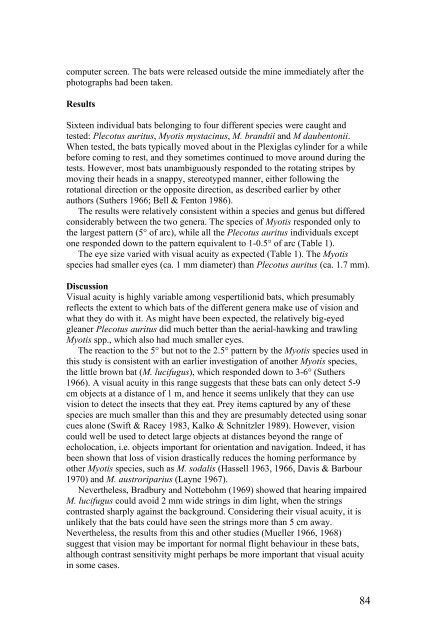Vision in echolocating bats - Fladdermus.net
Vision in echolocating bats - Fladdermus.net
Vision in echolocating bats - Fladdermus.net
You also want an ePaper? Increase the reach of your titles
YUMPU automatically turns print PDFs into web optimized ePapers that Google loves.
computer screen. The <strong>bats</strong> were released outside the m<strong>in</strong>e immediately after the<br />
photographs had been taken.<br />
Results<br />
Sixteen <strong>in</strong>dividual <strong>bats</strong> belong<strong>in</strong>g to four different species were caught and<br />
tested: Plecotus auritus, Myotis mystac<strong>in</strong>us, M. brandtii and M daubentonii.<br />
When tested, the <strong>bats</strong> typically moved about <strong>in</strong> the Plexiglas cyl<strong>in</strong>der for a while<br />
before com<strong>in</strong>g to rest, and they sometimes cont<strong>in</strong>ued to move around dur<strong>in</strong>g the<br />
tests. However, most <strong>bats</strong> unambiguously responded to the rotat<strong>in</strong>g stripes by<br />
mov<strong>in</strong>g their heads <strong>in</strong> a snappy, stereotyped manner, either follow<strong>in</strong>g the<br />
rotational direction or the opposite direction, as described earlier by other<br />
authors (Suthers 1966; Bell & Fenton 1986).<br />
The results were relatively consistent with<strong>in</strong> a species and genus but differed<br />
considerably between the two genera. The species of Myotis responded only to<br />
the largest pattern (5° of arc), while all the Plecotus auritus <strong>in</strong>dividuals except<br />
one responded down to the pattern equivalent to 1-0.5° of arc (Table 1).<br />
The eye size varied with visual acuity as expected (Table 1). The Myotis<br />
species had smaller eyes (ca. 1 mm diameter) than Plecotus auritus (ca. 1.7 mm).<br />
Discussion<br />
Visual acuity is highly variable among vespertilionid <strong>bats</strong>, which presumably<br />
reflects the extent to which <strong>bats</strong> of the different genera make use of vision and<br />
what they do with it. As might have been expected, the relatively big-eyed<br />
gleaner Plecotus auritus did much better than the aerial-hawk<strong>in</strong>g and trawl<strong>in</strong>g<br />
Myotis spp., which also had much smaller eyes.<br />
The reaction to the 5° but not to the 2.5° pattern by the Myotis species used <strong>in</strong><br />
this study is consistent with an earlier <strong>in</strong>vestigation of another Myotis species,<br />
the little brown bat (M. lucifugus), which responded down to 3-6° (Suthers<br />
1966). A visual acuity <strong>in</strong> this range suggests that these <strong>bats</strong> can only detect 5-9<br />
cm objects at a distance of 1 m, and hence it seems unlikely that they can use<br />
vision to detect the <strong>in</strong>sects that they eat. Prey items captured by any of these<br />
species are much smaller than this and they are presumably detected us<strong>in</strong>g sonar<br />
cues alone (Swift & Racey 1983, Kalko & Schnitzler 1989). However, vision<br />
could well be used to detect large objects at distances beyond the range of<br />
echolocation, i.e. objects important for orientation and navigation. Indeed, it has<br />
been shown that loss of vision drastically reduces the hom<strong>in</strong>g performance by<br />
other Myotis species, such as M. sodalis (Hassell 1963, 1966, Davis & Barbour<br />
1970) and M. austroriparius (Layne 1967).<br />
Nevertheless, Bradbury and Nottebohm (1969) showed that hear<strong>in</strong>g impaired<br />
M. lucifugus could avoid 2 mm wide str<strong>in</strong>gs <strong>in</strong> dim light, when the str<strong>in</strong>gs<br />
contrasted sharply aga<strong>in</strong>st the background. Consider<strong>in</strong>g their visual acuity, it is<br />
unlikely that the <strong>bats</strong> could have seen the str<strong>in</strong>gs more than 5 cm away.<br />
Nevertheless, the results from this and other studies (Mueller 1966, 1968)<br />
suggest that vision may be important for normal flight behaviour <strong>in</strong> these <strong>bats</strong>,<br />
although contrast sensitivity might perhaps be more important that visual acuity<br />
<strong>in</strong> some cases.<br />
84


